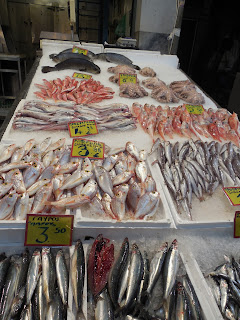Γεια σας, σε όλους τους αναγνώστες μου.
Today I visited two of Athens' agoras. Agora literally translates as "gathering place" and is the foundation of the word agoraphobia...fear of public places. I went to the Central Market Agora first and then the ancient Athenian Agora, now ruins but once the heart of Greek life and culture.
The Central Market of Athens is the main food market of the city. It's where the general public can buy their food and where chefs go to pick up the ingredients for today's specials. It sprawls for what seems like blocks and contains every kind of edible item imaginable. The Central Market stalls, at least in the meat and fish sections, are not for the faint of heart...or those with weak stomachs or an aversion to strong smells. Here's another tip..if you ever visit the Central Market, wear good shoes. The floors are wet and slimy, and I felt sorry for the tourists I saw wearing flip-flops. One poor girl in sandals had stepped into something bloody in the meat section, and in her hurry to get out had taken a wrong turn and was mortified to find herself in the slime of the fish section. Her face looked absolutely green as she searched around frantically for an opening to the street. I'm guessing that, once she found her way out of the labyrinth of stalls, she was headed directly to purchase new shoes. I have to admit, even being as much of a foodie as I am, it was overwhelming for me, too. I had planned to eat lunch at one of the 4 restaurants located within the market, as I had heard these had some of the freshest and most authentic meals in Athens...but the sights and smells were too much for me. It was a good hour or so after leaving before my appetite returned.
In the meat section, whole animals hang from hooks, being butchered apart on the spot. Intestines and organs hang from other hooks along the way. Whole chickens and turkeys, some still in the process of being de-feathered, hang alongside. Large and small cuts of select meats and organs sit ready for sale on blocks of ice. In the fish section, every imaginable kind of seafood can be purchased. From the tiniest sardines to whole octopus, it's all there. Big beautiful salmon and tuna are on display. You can buy them whole or have them filleted before taking them home wrapped in a cone of white butcher paper and stuffed into a blue plastic sack.
For those with less carnivorous tastes, the fruit and produce market is just across the street from the meat and fish stalls. Here you can purchase fruits, veggies, grains, nuts, dried beans, marinated and fresh olives, dozens of varieties of cheese, herbs, and spices. The selection is incredible and the prices are low. There must be hundreds of vendors, so competition is fierce. Just like in the souvenir shops of the Plaka, every butcher, fishmonger, and vendor is pushing their product as the very best at the lowest price.
I strolled around for while, eventually had lunch, and then headed for the ancient agora. It dates back to the 6th century BC, and during the time of Classical Greece it was the center of the world. It's where the government operated and vendors sold their wares. It was once filled with theatres, markets, fountains, statues, and temples to the Gods. Most of it is rubble now, but the Temple of Hephaestus is still in remarkably good shape considering it is over 2400 years old. The Athenian Agora remained the central square of Greece, even throughout the rein of the Roman Emperors.
As you walk along the main street of the Agora, the Panathenaic Way, you realize you are walking the same path taken by Socrates, Plato, Aristotle, and Solon. You are standing in the birthplace of democracy. It's an amazing feeling. I reached down, picked up a stone from the ground, and put it in my pocket...the only material souvenir I will keep from my journeys.
Today's activities in pictures...
Looking down through the meat section of the Central Market. I have close-ups, but I'll spare you. Just be glad these pictures don't come with the smell.
All kinds of fish for sale.
This guy is telling me that his produce is the freshest in the market.
Beans and grains. This first bag has what the Greeks call "giant beans." It's like a large butter bean and they cook them with tomatoes and herbs. I had some with my dinner a few nights ago and they were delicious.
The variety of olives is amazing. And, they let you sample for free!
A cheese shop.
A dried spice vendor...unlike the meat and fish stalls, this place smelled so good!
My lunch...a sampling of moussaka (a Greek lasagna), a zucchini fritter, a cheese croquet, tomatoes, and a piece of fried halloumi cheese.
Statues of giants and titans that once lined the Odeon of Agrippa in the Ancient Agora of Athens.
The Temple of Hephaestus. It's the most well-preserved temple I've seen, and it was completed in 415BC. Amazing that it still stands! Hephaestus was the god of craftsmen, so maybe it really has been blessed.
This a bust of Roman Emperor Antoninus Pius (emperor 138AD-161AD) at the Ancient Agora Museum.











No comments:
Post a Comment